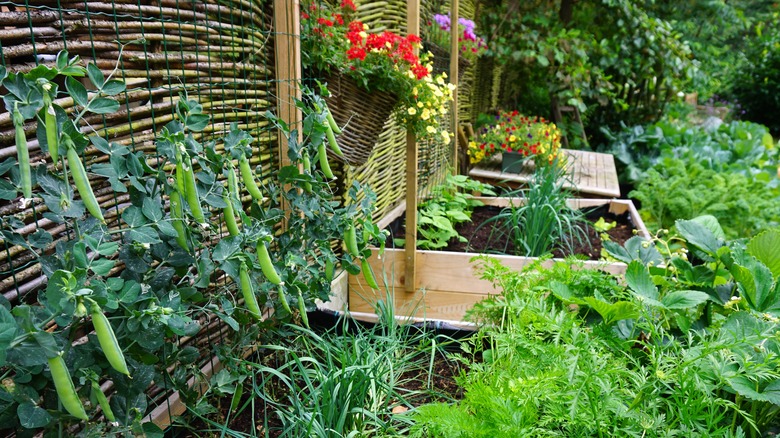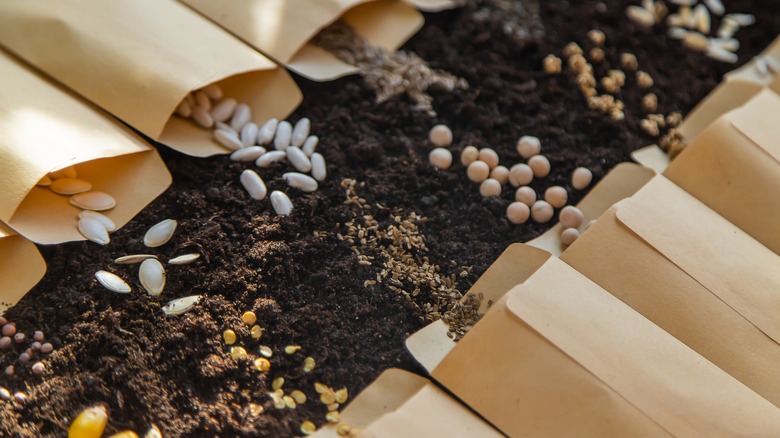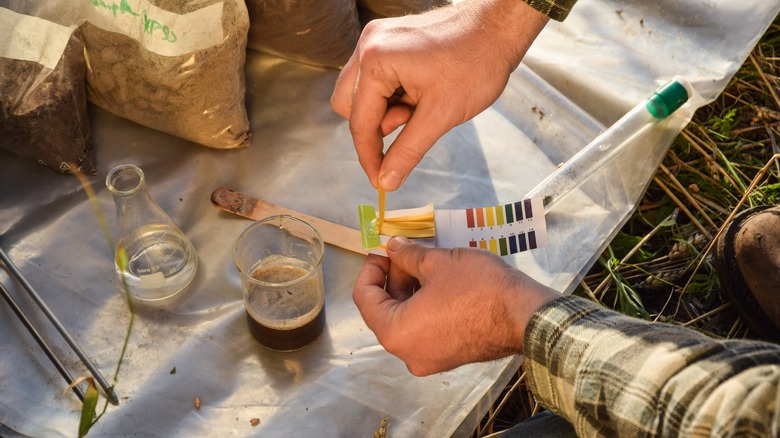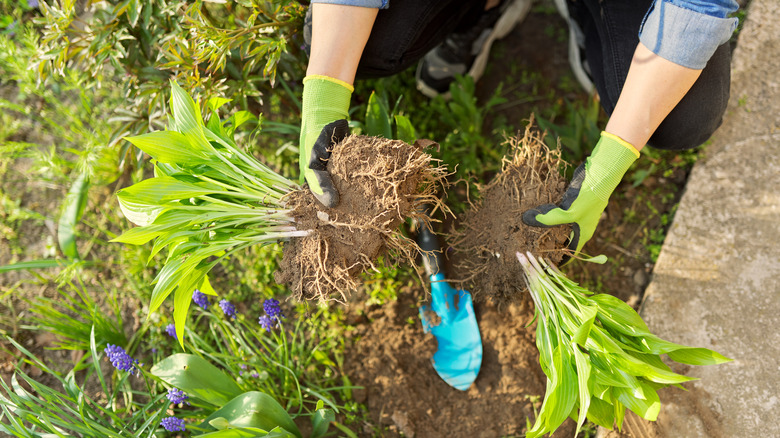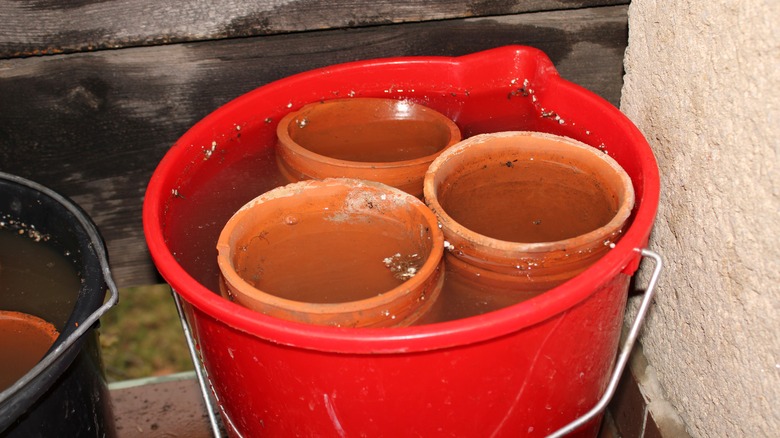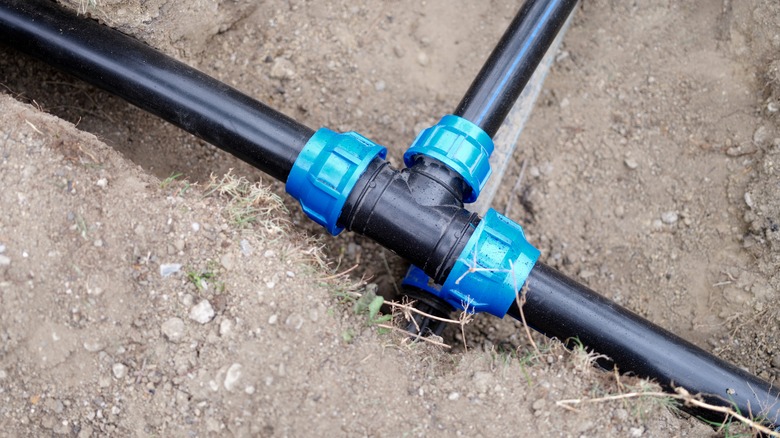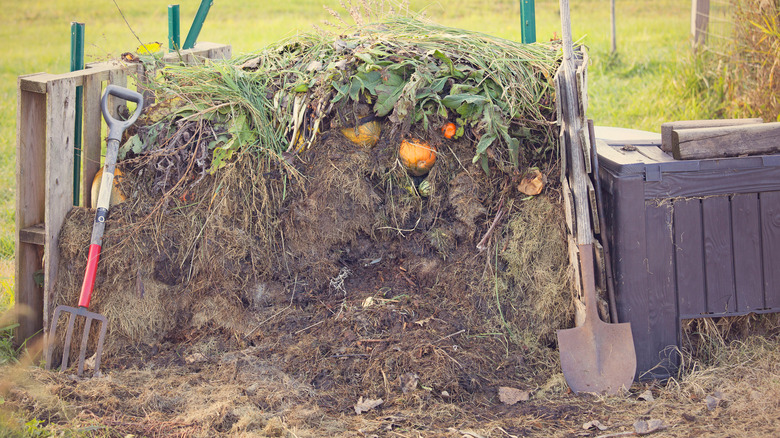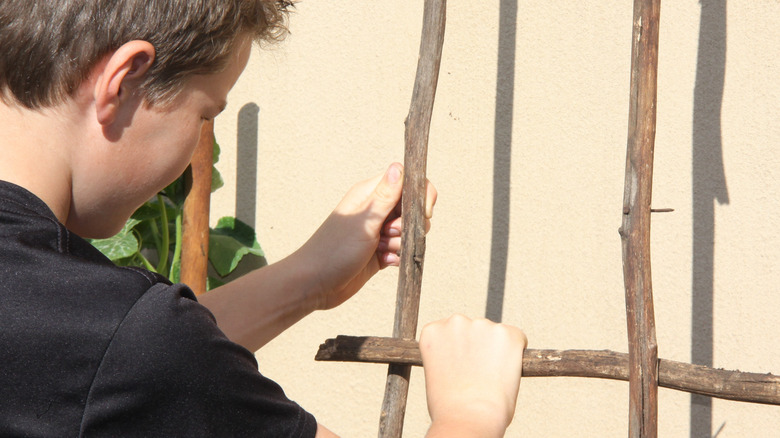How To Spring Clean Your Garden For A Breezy Planting Season
Late winter and early spring have always been busy times for gardeners. You're getting everything organized to spend half a year (or more) caring for plants and not worrying about things like maintaining irrigation systems and patching up trellises. Flower and food gardens present slightly different cleaning challenges. Still, in general, you can look forward to planning, creating, and repairing aspects of the garden itself, planning its various inputs (like new seeds, plants, and compost), and gathering the tools you'll work with all year.
The recent trend is to put off fall cleaning to interfere as little as possible with your garden's ecosystem, and that's only made the spring cleaning chore list bigger and a little more complicated. For example, those spent plants you didn't clean up in the fall to protect overwintering pollinators sheltered among them now have to be disposed of in short ord. Your compost system must also be prepared for a sudden influx of new material.
But this is all good stuff, and it's a favorite time of year for many gardeners. In fact, one of your spring cleaning goals should be to set yourself up to cultivate the best possible experience in your garden this year. Let's take a look at how.
Planning the planting
Just as spring cleaning your home involves lots of decluttering and organizing, your garden will require some thoughtful reordering to keep things manageable throughout the growing season. Cleaning without organization is like tidying up your kitchen without putting things away; everything might be spic and span, but you'll struggle to get anything done in there.
As tempting as it might be to jump straight into organizing seeds and making new labels and tags for your plantings, you first have to get a handle on your goals and projects for the year. A vegetable garden will need the usual attention to space planning. Some questions to consider when drawing up your planting plans: Where are you in your crop rotation plan this year? How many feet of each crop do you need for the year's production goals, taking seed saving into account? How do you factor isolation distances for companion plantings that could cross-pollinate (various varieties of tomato, for example)? Do you have new beds? Plants you want to completely isolate? New crops that will take up enormous amounts of space, like grains?
Organize your seeds, inventory what you have, and get anything you need ordered as soon as possible. Seed orders can take weeks (or more) this time of year, especially if you're buying from companies that cater to commercial growers.
Use garden journals or apps to map out your plan
There are lots of tools available to help you with this. There are apps and desktop applications for garden planning. If you're a technically-inclined gardener, consider making your own database using a tool for non-technical folks, such as Memento or Airtable. You can easily grow and adjust these as your needs evolve. One size never fits all in a garden, and it probably won't even fit you as you grow from one year to the next.
Even if you use one of these tools, you'll need a notebook. A physical notebook might be the more aesthetically pleasing option, and it's tempting to enhance that with a gilt, leather-bound volume suitable for jotting down musings about Bach. Avoid this temptation; this thing will get rained on, chewed by insects and puppies, infested, disinfected, reinfected, buried alive, and uncovered accidentally with a sharp shovel at some point. What you need is mostly just something that will lie flat when opened. A spiral-bound, graph paper or dot-grid notebook can be bought from superstores for a few dollars. There are some good techy versions of this, too, if you are oriented thusly. Zoho's Notebook is a great cross-platform solution that lets you organize notes, lists, images, voice recordings, videos, and more, and it can even be used with the Zia AI voice assistant.
Finally, consider also keeping a naturalist's notebook for observations about flora and fauna in and around your garden. Keeping this notebook separate from your garden notebook will help you focus on the wildlife instead of getting bogged down in lists of drip irrigation components you need.
Preparing the garden itself
Fortunately, you won't spend the whole year merely thinking about your garden. In early spring, there will already be more than enough hands-on cleaning to do. You'll need to balance your planting schedule with the lifecycles of any pollinators that might be hibernating in last year's dead plants, then clear those away and use the material to give an early boost to this year's compost bounty. You'll also need to remove any mulch you've applied to the garden for winter protection, along with fruit-tree wraps and the like. Raking back the mulch will take some coordination to avoid damaging any emerging perennials, while also not choking them out by leaving the mulch too long.
Spring is also the time for a new round of soil testing and amendment, although the schedule and nature of amendment will vary a lot based on the type of garden you have and its particular contents. A couple of things you'll want to un-amend your garden soil with first include any pet poop and those assertive, early-rising garden citizens we call "weeds." You can never start weeding too early in some areas of the country, and you can never weed often enough, no matter where your garden grows.
Add soil or compost to your raised beds as needed. This is particularly important if you've used an underlayment of twigs or other coarse material in a Hugelkultur-style bed, since soil will tend to collapse into the gaps created by such material. If you are actually following a permaculture-style program, you'll want to pay particular attention to its prescriptions here. And always keep in mind that there's a risk of introducing pests and diseases when importing soil, so take it from nearby or, better, from an active compost pile.
Preparing the plants
Pruning and dividing perennials is definitely a cleaning task, but it's not always a spring cleaning task. How much and when to prune varies by plant. Fuchsia, for example, can be pruned almost to the ground in spring, while perennials like forsythia need a lighter touch. The result should be more and healthier growth, usually in a more pleasing shape. Compost immediately after pruning to help the plants recover.
Dividing and moving plants (of course, you can't do the former without doing the latter) in spring makes sense for many plants. You'll stimulate their growth while reducing the opportunities for disease created by overcrowding. Keep an eye on your weather report for an overcast day, then water well a day in advance. The combination should insulate the plants from shock and keep them from drying out during the division process. In general, you'll divide perennials in spring if they bloom in the fall, whereas spring- and summer-blooming plants (as well as perennials with fleshy or tuberous roots) will benefit from dividing in fall instead. The University of Minnesota extension service provides a good PDF guide to dividing specific perennials. It's also available as a Google spreadsheet.
Cleaning pots and tools
Of course, sometimes spring cleaning is just about plain cleaning, and there's probably a fair amount of it to be done. If you didn't do it in the fall, and you probably didn't, it's time to scrub soil, moss, and other residues from pots. As silly as it might feel to clean something you're about to dump dirt into, you don't want a bunch of pots serving as a new vector for last year's diseases to quickly take hold this year.
Properly disinfecting tools also help to prevent the spread of disease, and you should do it as often as necessary throughout the year. But it's always a good idea to get a clean start, and you can do it using any number of disinfectants and methods. For example, you can soak in a 10% bleach solution for 30 minutes; a good wipe-down with alcohol; a few minutes in a 10% trisodium phosphate (TSP) solution; or a bath in a 25% solution of pine oil cleaner. Other cleaners will work, but they probably come with cautions that make them unsuitable for gardening. By the way, this is also an opportune time to sharpen the hand tools that can be sharpened, whether they need it or not.
Fall is probably the season for deep-cleaning your potting bench, garden shed, and/or greenhouse, if for no other reason than to prevent grime from becoming more stubbornly attached over the off-season. But if you didn't take care of those things then, now's certainly the right time to give everything a good scrub. You won't have room or time for it later.
Repairs and maintenance
Just as you wouldn't clean a broken toaster and then leave it sitting on the counter indefinitely, you don't want to breeze through your spring cleaning only to discover that your sparkling clean rainwater barrels aren't collecting any water. Now's the time to check out your gear and ensure everything is in good working order for the year. That can mean simple cleaning, maintenance, repair, or even replacement.
There are as many sprinkler and irrigation systems as there are gardens, so only you can know exactly what needs to be done. But it's certain that, if you don't find and fix the trouble spots now, they'll let you know with great drama when it has become too late. To avoid dealing with a flooded garden (or, worse, basement or greenhouse), do a test run on an early-season warm day. Look carefully for leaks, bulges, discolorations, and anything else that seems even slightly out of order. Pay particularly close attention to garden hoses and any plastic fittings. Garden hoses, unless you've paid a king's ransom for them, are notorious for not weathering well, and if they haven't been kept out of the cold over the winter, they'll almost certainly be in worse shape in the spring. The same is true of some plastic fittings, though not all. Irrigation fittings tend to be fairly durable but will become brittle over time. But plastic quick-connectors, for example, will rarely hold their strength for a year of constant exposure to weather. Spring is also your last convenient chance to do any repairs and maintenance on your rainwater collection system, and any power equipment that makes its way into your garden shed.
Kick-start compost
Spring is the time to reinvigorate your compost. Whether yours is in a bin under your kitchen sink or in a three-bay setup that has to be turned with a tractor, there's a right way and a wrong way to prep your compost operation for the season. Since this is spring cleaning time, you'll be moving plant material from your garden to your compost setup, but a plan is in order. Put whatever you want in your compost, but don't turn any of last year's plant material under until you're sure any beneficial insects harbored there have had time to emerge. The date for this will depend on your particular area. Once your local temperatures remain at 50 degrees Fahrenheit, you're probably safe to work your compost as usual.
Odds are that your compost pile itself is dormant at the beginning of spring. Warmer weather will get things working again soon enough. Just be sure to water the compost and turn it fairly frequently to get air to every part of the pile. Your garden waste and a winter's worth of compostable stuff will be cooking in no time.
One related note: While you won't usually add cover crops to your compost, you will want to get it decomposing in time for it to be useful to your plants. So work them into the garden soil a few weeks before you start to plant.
Structure repairs
Spring is also the time to get your garden structures in order. You don't want to move a trellis back into place while laden with summer vegetables. As with irrigation systems, your needs here will be particular to your garden.
Trellises and other support structures are certainly a priority, and there's a nearly endless variety of them. Vegetable gardens tend to have beefier supports, while flower gardens might have more permanent structures that are more difficult to repair. Fill an apron, toolbelt, or toolbox with some staples, including staples, and work through them one at a time. You might require twine or galvanized wire, fence staples, screws, nails, clamps (for holding things in place while you work), a hammer, a cordless screwdriver of some sort, and dedicated wire cutters. You should never cut anything, especially wire, with your garden shears. They're made for plants, and it's safe to assume you'll damage them with more demanding work. Also, take along a paint marker for updating any labels or tags along the way.
Are your raised beds in good repair? How about gates, fences, and edging? You might as well handle repairs to those at the same time. And look closely at anything offbeat or easily forgotten, like row covers, if you use them. You will probably find that they've somehow acquired tears, missing pieces, or possibly even a new life somewhere unknown and possibly far away. It's best to find that out early in the season so you can take care of it before your plants pay the price.
